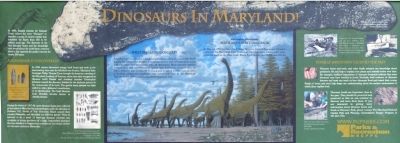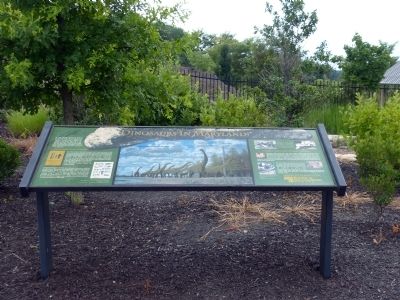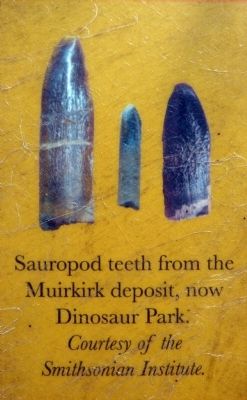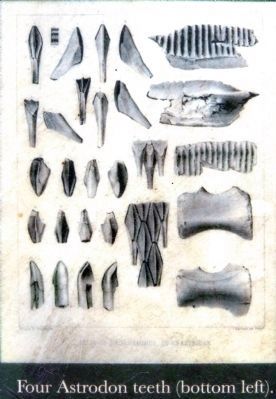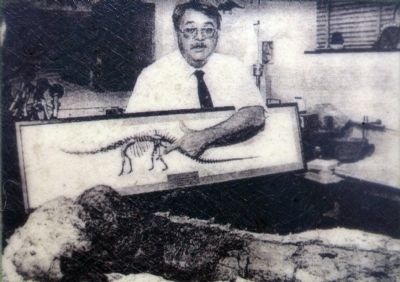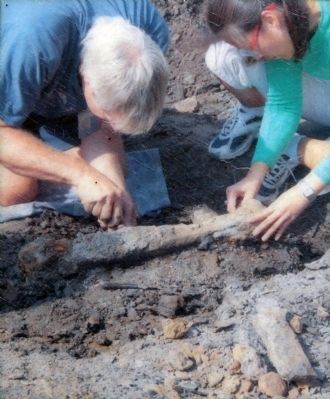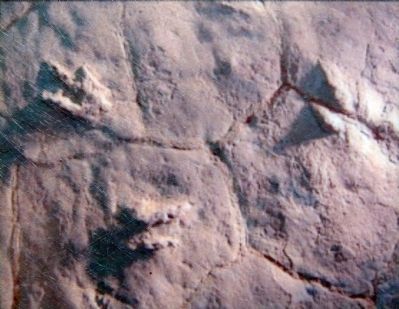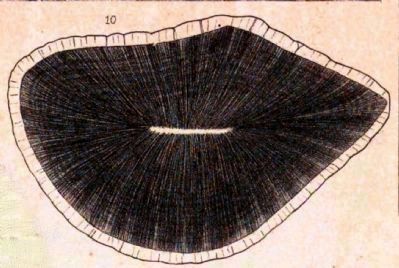Laurel in Prince George's County, Maryland — The American Northeast (Mid-Atlantic)
Dinosaurs in Maryland!
In 1842, English scientist Sir Richard Owen coined the term "dinosaur" to describe a group of ancient reptiles that inhabited the Earth from 230 to 65 million years ago. The discovery of the first dinosaur bones and the knowledge they reveal about the world these creatures lived in has captured the public's interest for nearly 200 years.
In 1858, miners discovered strange fossil bones and teeth in the iron-bearing clays near the Muirkirk iron furnace. Maryland State Geologist Phillip Thomas Tyson brought the bones to a meeting of the Maryland Academy of Sciences, where they were recognized as dinosaur teeth! Dentist and Academy member Christopher Johnston named the dinosaur Astrodon for the starburst pattern in the cross section of its teeth. The species name johnstoni was later added to reflect Johnston's contribution to its identification. The fossil dinosaur from Muirkirk became known as Astrodon johnstoni.
During the winter of 1887-88, more dinosaur bones were collected at iron mines in Maryland by paleontologists under the direction of Professor O.C. Marsh of Yale University. Marsh named these remains Pleurocoelus, and identified two different species. What he believed to be a small 12 foot long dinosaur, scientists now recognize as young specimens of a large, long-necked sauropod. Because Astrodon is so fragmentary scientists are not certain whether is the same animal as Pleurocoelus.
Fossils-Important Clues to the Past
Dinosaur bones and teeth, and other fossils enhance our knowledge about prehistoric life and help to explain how plants and animals evolve over time. For example, fossilized impressions of dinosaur footprints indicate that some dinosaurs may have traveled in herds. Similarly, fossil evidence of dinosaur burrows and nests can teach us how dinosaurs lived and raised their young,. Fossils of leaves and trees help shape our understanding about the ancient environment in which these reptiles lived.
Dinosaur fossils are important clues to the past. They should be protected and preserved so that we can continue to discover and learn from them. If you are interested in getting more information about dinosaur bones and fossils at Dinosaur Park, please contact The Maryland-National Park and Planning Commission's Ranger Program 301-627-7755.
Erected by Maryland-National Capital Parks and Planning Commission.
Topics. This historical marker is listed in these topic lists: Animals • Paleontology. A significant historical year for this entry is 1842.
Location. This marker has been replaced by another marker nearby. It was located near 39° 4.245′ N, 76° 52.121′ W. Marker was in Laurel, Maryland, in Prince George's County. Marker could be reached from Mid Atlantic Boulevard, 0.4 miles south of Contee Road when traveling west. The marker stood in Dinosaur Park. Touch for map. Marker was at or near this postal address: 13100 Mid Atlantic Blvd, Laurel MD 20708, United States of America. Touch for directions.
Other nearby markers. At least 8 other markers are within walking distance of this location. The Industrial Heritage of Dinosaur Park (here, next to this marker); The Dinosaurs of Dinosaur Park (here, next to this marker); Welcome to Dinosaur Park (a few steps from this marker); Meet Astrodon johnstoni (a few steps from this marker); a different marker also named Welcome to Dinosaur Park (a few steps from this marker); George Washington Carver (approx. 0.4 miles away); Veterans Memorial (approx. 0.4 miles away); Three Sisters: Close Knit Communities of the Laurel Area (approx. 0.8 miles away). Touch for a list and map of all markers in Laurel.
Related marker. Click here for another marker that is related to this marker. This marker has been replaced by the linked marker.
Also see . . .
1. Astrodon johnstoni. Discussed by dinosaur hunter Peter Kranz, at the University of Maryland. (Submitted on July 31, 2013, by Allen C. Browne of Silver Spring, Maryland.)
2. Dinosaurs in Our Backyard. An interactive
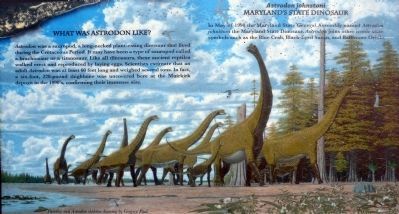
Photographed By Allen C. Browne, July 28, 2013
3. What was Astrondon Like?
Astrondon was a sauropod, a long-necked plant-eating dinosaur that lived during the Cretaceous Period. It may havebeen a type of sauropod called a brachiosaur of a titanosaur. Like all dinosaurs, these ancient reptiles walked erect and reproduced by laying eggs. Scientists estimate that as adult Astrodon was at least 60 feet long and weighed several tons. In fact a six-foot, 220-pound thighbone was uncovered here at the Muirkirk deposit in the 1990's, confirming their immense size.
Astrodon johnstoni
Maryland's State Dinosaur
In May of 1998, the Maryland State General Assembly named Astrondon johnstoni the Maryland State Dinosaur. Astrodon joins other iconic state symbols such as the Blue Crab, Black-Eyed Susan, and Baltimore Oriole.Close-up of image on marker
Painting by Gregory Paul
Maryland's State Dinosaur
In May of 1998, the Maryland State General Assembly named Astrondon johnstoni the Maryland State Dinosaur. Astrodon joins other iconic state symbols such as the Blue Crab, Black-Eyed Susan, and Baltimore Oriole.
Painting by Gregory Paul
Additional commentary.
1. State Dinosaur of Two States
If Pleurocoelus and Astrodon really are the same creature, it has the distinction of having been the State Dinosaur of both Maryland and Texas. Pleurocoelus became the Texas State Dinosaur in 1997 but was replaced by Paluxysaurus in 2009.
— Submitted July 31, 2013, by Allen C. Browne of Silver Spring, Maryland.
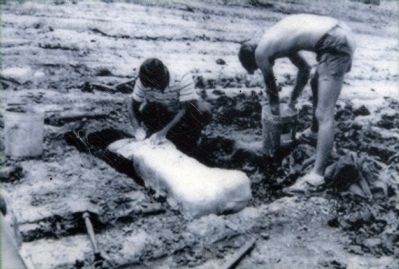
Photographed By Allen C. Browne, July 28, 2013
6. Astrodon femur cast extracted by Dan Chaney (left) and Peter Kroehler
In June of 1991 Arnold Norden and his two children were searching for fossils at Murikirk and found a thighbone or femur, from an Astrondon. The bone was about six feet long and weighed about 220 pounds. Close-up of photo on marker
Credits. This page was last revised on December 11, 2021. It was originally submitted on July 31, 2013, by Allen C. Browne of Silver Spring, Maryland. This page has been viewed 985 times since then and 32 times this year. Photos: 1, 2, 3, 4, 5, 6, 7, 8, 9, 10, 11. submitted on July 31, 2013, by Allen C. Browne of Silver Spring, Maryland. • Bill Pfingsten was the editor who published this page.
